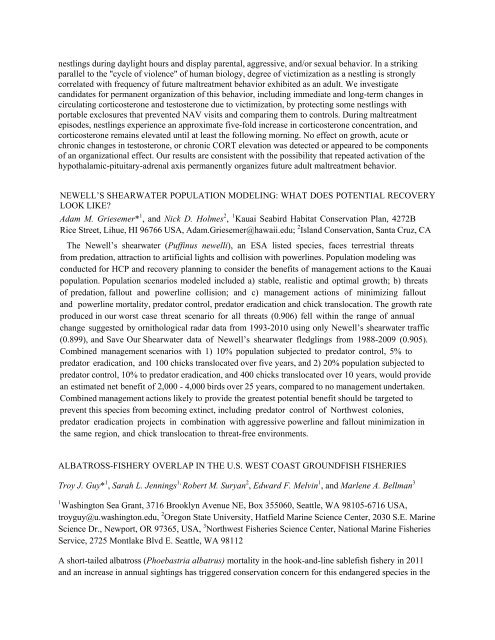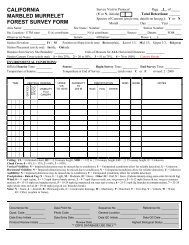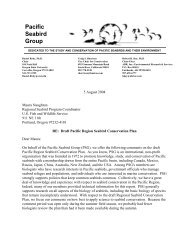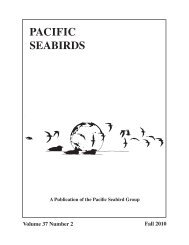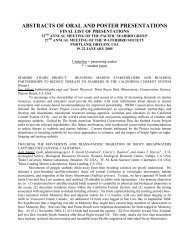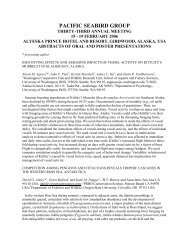PSG 2012 Hawaii abstracts - Pacific Seabird Group
PSG 2012 Hawaii abstracts - Pacific Seabird Group
PSG 2012 Hawaii abstracts - Pacific Seabird Group
You also want an ePaper? Increase the reach of your titles
YUMPU automatically turns print PDFs into web optimized ePapers that Google loves.
nestlings during daylight hours and display parental, aggressive, and/or sexual behavior. In a striking<br />
parallel to the "cycle of violence" of human biology, degree of victimization as a nestling is strongly<br />
correlated with frequency of future maltreatment behavior exhibited as an adult. We investigate<br />
candidates for permanent organization of this behavior, including immediate and long-term changes in<br />
circulating corticosterone and testosterone due to victimization, by protecting some nestlings with<br />
portable exclosures that prevented NAV visits and comparing them to controls. During maltreatment<br />
episodes, nestlings experience an approximate five-fold increase in corticosterone concentration, and<br />
corticosterone remains elevated until at least the following morning. No effect on growth, acute or<br />
chronic changes in testosterone, or chronic CORT elevation was detected or appeared to be components<br />
of an organizational effect. Our results are consistent with the possibility that repeated activation of the<br />
hypothalamic-pituitary-adrenal axis permanently organizes future adult maltreatment behavior.<br />
NEWELL’S SHEARWATER POPULATION MODELING: WHAT DOES POTENTIAL RECOVERY<br />
LOOK LIKE<br />
Adam M. Griesemer* 1 , and Nick D. Holmes 2 , 1 Kauai <strong>Seabird</strong> Habitat Conservation Plan, 4272B<br />
Rice Street, Lihue, HI 96766 USA, Adam.Griesemer@hawaii.edu; 2 Island Conservation, Santa Cruz, CA<br />
The Newell’s shearwater (Puffinus newelli), an ESA listed species, faces terrestrial threats<br />
from predation, attraction to artificial lights and collision with powerlines. Population modeling was<br />
conducted for HCP and recovery planning to consider the benefits of management actions to the Kauai<br />
population. Population scenarios modeled included a) stable, realistic and optimal growth; b) threats<br />
of predation, fallout and powerline collision; and c) management actions of minimizing fallout<br />
and powerline mortality, predator control, predator eradication and chick translocation. The growth rate<br />
produced in our worst case threat scenario for all threats (0.906) fell within the range of annual<br />
change suggested by ornithological radar data from 1993-2010 using only Newell’s shearwater traffic<br />
(0.899), and Save Our Shearwater data of Newell’s shearwater fledglings from 1988-2009 (0.905).<br />
Combined management scenarios with 1) 10% population subjected to predator control, 5% to<br />
predator eradication, and 100 chicks translocated over five years, and 2) 20% population subjected to<br />
predator control, 10% to predator eradication, and 400 chicks translocated over 10 years, would provide<br />
an estimated net benefit of 2,000 - 4,000 birds over 25 years, compared to no management undertaken.<br />
Combined management actions likely to provide the greatest potential benefit should be targeted to<br />
prevent this species from becoming extinct, including predator control of Northwest colonies,<br />
predator eradication projects in combination with aggressive powerline and fallout minimization in<br />
the same region, and chick translocation to threat-free environments.<br />
ALBATROSS-FISHERY OVERLAP IN THE U.S. WEST COAST GROUNDFISH FISHERIES<br />
Troy J. Guy* 1 , Sarah L. Jennings 1, Robert M. Suryan 2 , Edward F. Melvin 1 , and Marlene A. Bellman 3<br />
1 Washington Sea Grant, 3716 Brooklyn Avenue NE, Box 355060, Seattle, WA 98105-6716 USA,<br />
troyguy@u.washington.edu, 2 Oregon State University, Hatfield Marine Science Center, 2030 S.E. Marine<br />
Science Dr., Newport, OR 97365, USA, 3 Northwest Fisheries Science Center, National Marine Fisheries<br />
Service, 2725 Montlake Blvd E. Seattle, WA 98112<br />
A short-tailed albatross (Phoebastria albatrus) mortality in the hook-and-line sablefish fishery in 2011<br />
and an increase in annual sightings has triggered conservation concern for this endangered species in the


